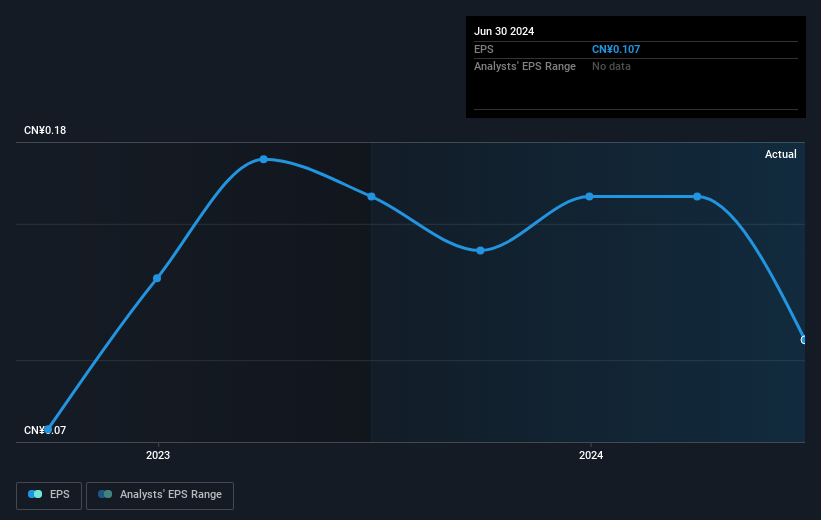- China
- /
- Electrical
- /
- SHSE:600261
Investors who have held Zhejiang Yankon Group (SHSE:600261) over the last five years have watched its earnings decline along with their investment

Zhejiang Yankon Group Co., Ltd. (SHSE:600261) shareholders should be happy to see the share price up 12% in the last week. But that doesn't change the fact that the returns over the last five years have been less than pleasing. In fact, the share price is down 37%, which falls well short of the return you could get by buying an index fund.
The recent uptick of 12% could be a positive sign of things to come, so let's take a look at historical fundamentals.
See our latest analysis for Zhejiang Yankon Group
To paraphrase Benjamin Graham: Over the short term the market is a voting machine, but over the long term it's a weighing machine. One flawed but reasonable way to assess how sentiment around a company has changed is to compare the earnings per share (EPS) with the share price.
Looking back five years, both Zhejiang Yankon Group's share price and EPS declined; the latter at a rate of 23% per year. The share price decline of 9% per year isn't as bad as the EPS decline. So investors might expect EPS to bounce back -- or they may have previously foreseen the EPS decline.
The image below shows how EPS has tracked over time (if you click on the image you can see greater detail).

This free interactive report on Zhejiang Yankon Group's earnings, revenue and cash flow is a great place to start, if you want to investigate the stock further.
What About Dividends?
When looking at investment returns, it is important to consider the difference between total shareholder return (TSR) and share price return. The TSR is a return calculation that accounts for the value of cash dividends (assuming that any dividend received was reinvested) and the calculated value of any discounted capital raisings and spin-offs. Arguably, the TSR gives a more comprehensive picture of the return generated by a stock. In the case of Zhejiang Yankon Group, it has a TSR of -19% for the last 5 years. That exceeds its share price return that we previously mentioned. The dividends paid by the company have thusly boosted the total shareholder return.
A Different Perspective
While the broader market lost about 6.0% in the twelve months, Zhejiang Yankon Group shareholders did even worse, losing 20% (even including dividends). Having said that, it's inevitable that some stocks will be oversold in a falling market. The key is to keep your eyes on the fundamental developments. Regrettably, last year's performance caps off a bad run, with the shareholders facing a total loss of 4% per year over five years. We realise that Baron Rothschild has said investors should "buy when there is blood on the streets", but we caution that investors should first be sure they are buying a high quality business. It's always interesting to track share price performance over the longer term. But to understand Zhejiang Yankon Group better, we need to consider many other factors. Case in point: We've spotted 4 warning signs for Zhejiang Yankon Group you should be aware of, and 1 of them is a bit concerning.
We will like Zhejiang Yankon Group better if we see some big insider buys. While we wait, check out this free list of undervalued stocks (mostly small caps) with considerable, recent, insider buying.
Please note, the market returns quoted in this article reflect the market weighted average returns of stocks that currently trade on Chinese exchanges.
Valuation is complex, but we're here to simplify it.
Discover if Zhejiang Yankon Group might be undervalued or overvalued with our detailed analysis, featuring fair value estimates, potential risks, dividends, insider trades, and its financial condition.
Access Free AnalysisHave feedback on this article? Concerned about the content? Get in touch with us directly. Alternatively, email editorial-team (at) simplywallst.com.
This article by Simply Wall St is general in nature. We provide commentary based on historical data and analyst forecasts only using an unbiased methodology and our articles are not intended to be financial advice. It does not constitute a recommendation to buy or sell any stock, and does not take account of your objectives, or your financial situation. We aim to bring you long-term focused analysis driven by fundamental data. Note that our analysis may not factor in the latest price-sensitive company announcements or qualitative material. Simply Wall St has no position in any stocks mentioned.
About SHSE:600261
Zhejiang Yankon Group
Engages in the research and development, production, and sales of lighting appliances in China.
Flawless balance sheet, good value and pays a dividend.

